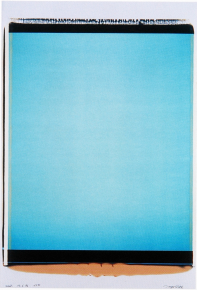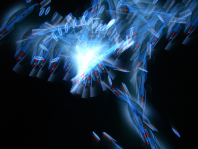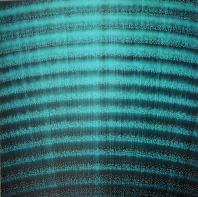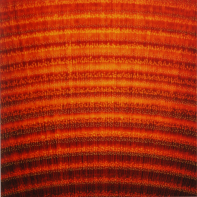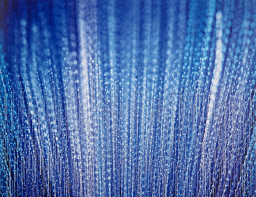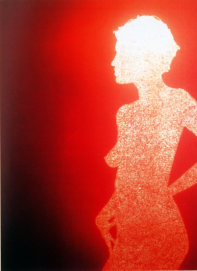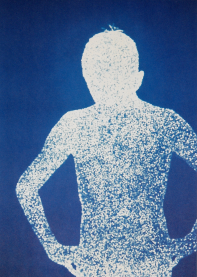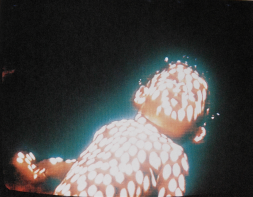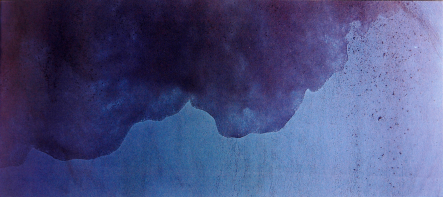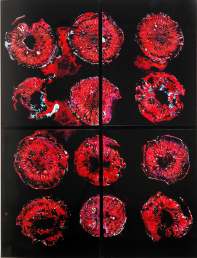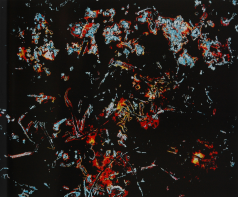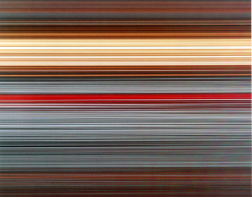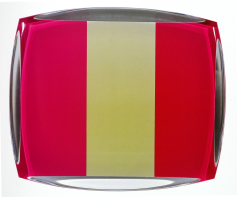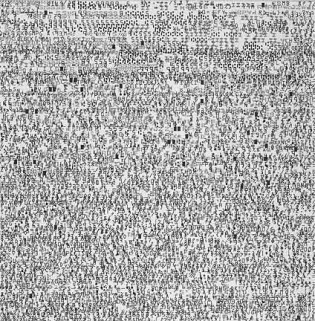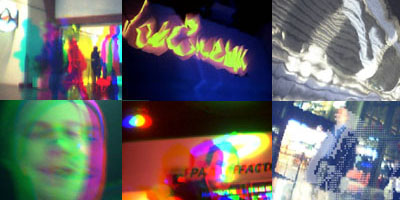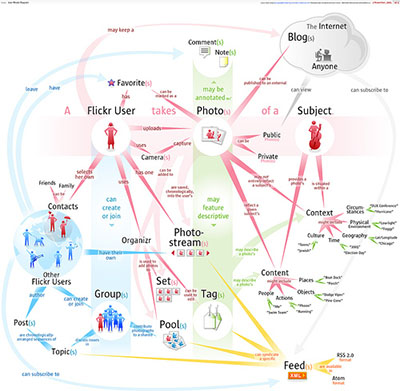Why should not the camera also throw off the shackles of conventional representation and attempt something fresh and untried?...... Think of the joy of doing something which would be impossible to classify, or to tell which was the top and which was the bottom! Alvin Coburn 1916 - The Future of Pictorial Photography

As inhabitants of information society, our experiences are becoming increasing more complex and abstract. Concealed behind user-friendly graphical interfaces, most of us are not aware of the metadata, code and algorithms, driving searches on Google; recommending purchases from Amazon.com; calibrating photos in Photoshop; even communicating via email. It has been suggested that abstraction is an appropriate concept and aesthetic to articulate this contemporary experienceManovich 2004. This is particularly evident in relation to data/network visualizations.
The 2003 project  ABSTRACTION NOW presented as online and offline exhibition, examined "current tendencies of non-representative art" from a "younger generation" of artists Pfaffenbichler 2004. Considered "a seminal exhibition on abstraction in contemporary art"
ABSTRACTION NOW presented as online and offline exhibition, examined "current tendencies of non-representative art" from a "younger generation" of artists Pfaffenbichler 2004. Considered "a seminal exhibition on abstraction in contemporary art"  Watz it included abstraction from many genres and media. The main focus of
Watz it included abstraction from many genres and media. The main focus of  ABSTRACTION NOW was to highlight how "artistic strategies of image-making have changed and expanded with the help of new media", with particular interest placed on "the process-related aspects within abstract creation"Pfaffenbichler 2004. Norbert Pfaffenbichler, who conceived and co-curated the project, explored the common link between all abstract art, and found that it centres around relationships - "relations between individual elements within images surfaces, between individual surfaces, and between the surfaces and space in which they exist"Pfaffenbichler 2004 p59. He adds that in the case of moving images, there is an additional factor - image/time relationship. Non-representational still and moving images have in common:
ABSTRACTION NOW was to highlight how "artistic strategies of image-making have changed and expanded with the help of new media", with particular interest placed on "the process-related aspects within abstract creation"Pfaffenbichler 2004. Norbert Pfaffenbichler, who conceived and co-curated the project, explored the common link between all abstract art, and found that it centres around relationships - "relations between individual elements within images surfaces, between individual surfaces, and between the surfaces and space in which they exist"Pfaffenbichler 2004 p59. He adds that in the case of moving images, there is an additional factor - image/time relationship. Non-representational still and moving images have in common:
The abstract representation always refers to itself and hence to the conditions of its own existence. In other words, what it negotiates is the conventions and, as a result, the states of representability in various (visual) media.Pfaffenbichler 2004 p59
Sandro Droschl, the other curator of  ABSTRACTION NOW, emphasizes the "interdisciplinary process-oriented approaches" of the works included in the exhibition, recognizing at the same time that "most of the works were conceived as self-referential". An understanding of the complex nature/system of abstraction, is evident in the curatorial aspects of this project. Droschl suggests "the works 'surveyed' assume a reconfigured capacity for connecting with other positions in the exhibition and within the extended reference/space". He goes on:
ABSTRACTION NOW, emphasizes the "interdisciplinary process-oriented approaches" of the works included in the exhibition, recognizing at the same time that "most of the works were conceived as self-referential". An understanding of the complex nature/system of abstraction, is evident in the curatorial aspects of this project. Droschl suggests "the works 'surveyed' assume a reconfigured capacity for connecting with other positions in the exhibition and within the extended reference/space". He goes on:
With an open debate on questions of the autonomy, formal integrity, and discursive connectivity of each position, the exhibition tries to establish a structural dispositif similar to a 'cognitive mapping', which offers links between individual fragmented artistic positions.Droschl 2004 p67
This mapping, acknowledges that the "many-layered exhibition display" offers possibilities for exploring the "connectivity of individual works in the context of a broader discussion of present-day abstraction"Droschl 2004 p67. Furthermore Droschl states that  ABSTRACTION NOW is ultimately designed for viewers to derive "their own maps on current issues around the production of 'abstract art'.
ABSTRACTION NOW is ultimately designed for viewers to derive "their own maps on current issues around the production of 'abstract art'.
Despite the renewed interest in abstraction as a concept, theory and discourse regarding non-representative photography is still lagging. In December 2000, the theme of the 21st Bielefeld Symposium on Photography and Media was Abstract Photography: The Visibility of the Image. In conjunction with the symposium "the first comprehensive art historical exhibition on abstract photography with over 200 works by artists of the 19th and 20th century" was held. The purpose was to demonstrate "the existence of an abstract tendency in photography".Jager 2002 p7
According to Gottfried Jager, abstraction is the 'second culture' of photographyJager 2002 p274. Whereas figurative photography has always had its place in the sun, non-figurative photography has never been "properly acknowledged in the field of art and art history". In tracing a history of non-figurative photography that goes back to the beginning of the 20th Century, Jager points out that "none of the numerous 'histories' of Abstract Art include noteworthy examples and portrayals of such work in the domain of photography". This is despite "remarkable achievements with regards to pictorial creativity".Jager 2002 p11
Abstract photography has also been marginalized in the history of photography. A.D. Coleman suggests the blame lies fairly and squarely with "the conservatism of photography's own historians and curators during the 1960s". In particular, Beaumont Newhall and Helmut Gersheim who "made no bones about their preference for photography as an informationally-oriented descriptive system and their disregard, even disdain, for alternative approaches to photographic practice. "
The trickle-down effect of that we see today: a context in which many assume that, aside from the paradigms represented by the Group f.64 and the New York School, photography has had no significant models of thoughtful praxis - and certainly none that involve process experimentation.Coleman 2001 p3
There is general consensus with regards to the exclusion of abstract photography from photography's history, theory and critique. There is also some degree of consensus about its purpose and significance. Gottfried Jager suggests that abstract photography is about "the self production of the medium", in fact, it is "the self-portrayal of the system itself"Jager 2002 p16. With photographic abstraction, "it is no longer what or who but how that is the focus of our interest" Jager 2002 p88 In fact, most authors on the subject explore the reflexive nature of abstract photography, and tend to frame discussions around the processes of generation. Derek Horton's catalogue essay, discussing the abstract photographs from Optic Nerve identifies:
Conventional notions of the indexical and documentary qualities of the photograph are necessarily challenged here, as are the conventions of how a photograph is made: for example some of these images are made without a camera, some without film, and in one case partly without light. Horton 2003 p2
He goes on to say that abstract photographs are images that "can be seen as embodying the strategies of their production". In his article on Process Photography, Roy Exley explains it as "a mode of photographic art where the nature of the eventual image is manipulated and shaped by processes......the bottom line is that process photography is a mode of photography whose chief referent is itself" Exley 2002 p19. In overviewing the significance of process photography Exley states:
The images are essentially investigative; dissecting layers of indexical familiarity, giving reality a makeover, shifting perceptual paradigms, questioning mechanisms of observation.Exley 2002 p20
The same consensus does not extend to the parameters of abstract photography. There is a tendency for discussions of abstract photography to drift towards essentialism. For example, despite the rhetoric of an open and inclusive approach to abstract photography, a panel discussion that raised the question of the inclusion of digital media revealed Gottfried Jager's bias - "Computers have the capacity to simulate the aesthetics of both conventional and abstract photography; they pretend to create real photos"Jager 2002 p280 The feelings of Jager are even clearer with regards to a discussion about Inge Dick's work:
Mibelbeck "She used blue colour, blue light actually, working on two parallel experiments: Firstly, the blue photographed; secondly the blue digitally saved; and both images are repeatedly enlarged. On the one hand, the grains of the photographic chemistry, on the other hand, the pixels of the computer image are made visible; the number of pixels is mathematically reduced in twelve steps until eventually only two blue rectangles remain. The product is the result of a digital, mathematical operation".
Jager Yes, but it is not a photo.
Mibelbeck It is an Ilfochrome!
Jager That is the picture carrier!
Excerpt from Discussion in The Art of Abstract Photography p283
Marie Robl is critical of this type of "medium specificity" linking it to a "greenbergesque kind of modernism". Lambert Weising's essay in Jager's The Art of Abstract Photography comes under scrutiny, for "an 'uncompromising self-reflection in the medium' which reveals the representational structures of photography without binding them to a specific purpose"Robl 2004 p77 . The fundamental difference between this dialogue about abstract photography and the intentions behind the  ABSTRACTION NOW project is that, with the latter there is:
ABSTRACTION NOW project is that, with the latter there is:
...no doubt that the 'pure' medium has long been a mere utopia and that reducing a work to the physicality of its medium can no longer provide meaningful information about it.Robl 2004 p77
Robl is correct in dispelling the usefulness of seeking a 'pure' medium. The boundaries of photography (and everything else for that matter) are continually changing, exchanging and evolving, (as well as being contingent on the observer's position/bias).As Lev Manovich points out "while photographs truly dominate contemporary visual culture, most of them are not pure photographs but various mutations and hybrids" Manovich 2004 . It seems absurd to fix/define/reduce what photography is or could be. Abstract photography in particular, need not be defined 'purely' in terms of its physicality. As Simon Cuthbert, curator of Tasmania's 1998 F:Divergent Abstraction and the Photographic Project explains, "abstraction can derive from literal or optical truths, from constructed images or the manipulation of process. It is not a singular stylistic affair. Its sources, purposes and results are multiple". Understanding photography as a complex system, opens up a space for photographic abstraction to be examined in terms of processes and interactions (as well as the many other marginalized photographic practices). Complexity emphasizes the study of the interactions of a system rather than focussing on the parts. Photographic abstraction, by its very nature, shifts the emphasis from the object to the processes of image generation (process over product; interactions over parts). In this way, abstract photography can be viewed in terms of the multiplicity of processes, interactions and outcomes, that constitute a complex system.
As a complex system, abstract photography can be considered in terms of clusters of processes and practices. From experimental techniques such as the Camera Toss which owes its current fame to a Flickr group, right through to Andreas Muller-Pohle's Digital Scores which abstracts a Nicephore Niepce photograph into data, links can be established with photographic abstraction. Furthermore, since there is such resistance in accepting abstract photography into many conventional photographic and art channels, photographic abstraction in many of its forms can be critiqued in terms of playing against the photographic program/apparatus. Via abstraction, photographers/artists "take the liberty of re-modelling the function of their apparatus and making it something different. They deliberately challenge it".Jager 2002 p16
Within this framework, the  Camera Toss becomes an example of playing against the camera. The results of which are highly indeterminate and not part of the camera program - as such they are in Flusserian terms "informative images". Camera tossers actively toss or throw their cameras - they are "outwitting the camera's rigidity"Flusser 2000 p80. In fact the camera must be airborne to qualify for the group:
Camera Toss becomes an example of playing against the camera. The results of which are highly indeterminate and not part of the camera program - as such they are in Flusserian terms "informative images". Camera tossers actively toss or throw their cameras - they are "outwitting the camera's rigidity"Flusser 2000 p80. In fact the camera must be airborne to qualify for the group:
....the technique here is regarded by some as insanity. For we the reckless folks on Flickr that enjoy the abstract, chance, generative, physical photography that results from throwing our cameras into the air.....It is about trading risk for reward in the pursuit of art....it is about enabling the photography that happens naturally when you let go of the process, give up control, and add a hell of alot more variables. It is about physics, gravity, angular momentum, acceleration, direction, chaos, and timing...most of which you have a tenuous control of at best!
Camera Toss Group
A Camera Tosser
Examples of camera-toss derived photographs
Processes that involve modifications to cameras/devices can also be viewed as playing against the camera. Process photographers such as Neil Reddy and Christopher Bucklow have developed and modified their apparatuses and in doing so, generated unique approaches to photography. They "force the camera to create the unpredictable, the improbable, the informative"Flusser 2000 p80.
Neil Reddy starts with standard camera components - camera, lens, film. His specially constructed box has a front panel made of metal foil pierced with multiple holes. The photographs are the result of a process of long exposures, in which he adjusts the focus and camera, "effectively superimposes the traces of light"Exley 2002 p21. As Roy Exley points out it is " Light show in miniature which only the camera witnesses". The resulting photographs are not representations of objects, "we are looking at surfaces that are constructed from light rather than reflecting it"Exley 2002 p21. Through this process, Reddy displaces the "photographic moment"Horton 2003.
Christopher Bucklow's photographic processes are camera-based. His apparatuses are based on the pinhole camera. In his series Guests Bucklow uses a lensless pinhole camera, inserting a "hand-made negative" which in effect is an image/silhouette created by making thousands of pinholes in an sheet of opaque material. The resulting images are captured directly onto photographic paper. Bucklow has also converted and constructed buildings into large pinhole cameras. Guest (Israel) is a video work in which multiple-pinholes are embedded in the roof of a purpose built building. The "guest" appeared on the walls or floor depending on the sun's position. Human bodies became the screens on which the solar images where projected, captured on video. Bucklow's photography extends across time, space and media.
Susan Derges and Daro Montag processes are predominantly cameraless, and vastly different. As process photography, what their images have in common is that they exist "as-evidence-of" process. Susan Derges' River Taw and Shoreline, are the result of Derges submerging photographic paper beneath the surface of a river at night, and exposes it briefly with a diffused flash. She "creates photograms which document the interaction between water and light".
Derges' photographic intervention in the flow of the river means that the subsequent image is also - true to the nature of process photography - partly an image of itself, of its presence reflected in the movement's of the river's surface.Exley 2002 p23
Daro Montag's evidence of process is found in decomposition. It is a "direct, physical interface with the environment"Exley 2002 p23. Montag's process involves the records of organic processes embedding themselves directly onto film. He does this by burying film or placing organic matter onto its surface generating what he has termed bioglyphs. In doing this biological processes/micro-organisms alter the film emulsion, making visible "the complexity of microscopic events". In this process Montag employs "the energy of decay".Horton 2003
David Hiscock believes the idea that photography has a "privileged relationship to reality" is a simplification and "fundamental distortion of the relationship between ourselves, our sight, and the world out there". His photographic processes is "a deliberate attempt to redress the 'monocular split-second representational view'"David Hiscock. Hiscock's purpose built camera allows film to move "scrolling steadily and very slowly past a thin slit aperture". It is an adaptation of a photo-finish camera, in which Hiscock stretches the "visual moment" and photography's indexicality.
Photographic abstraction can be employed as counter-practices and critiqued in terms of post-photography - challenging the dominance of the photographic product and offering critiques of photography via photographic means. "Abstraction, of course, usurps the traditional identity and ontology of the photograph, destabilizing it, shifting its parameters" Exley 1999. Photographic Abstraction , as post-photographic practice, has the potential to articulate photography's history, contemporary condition and future trajectories. In this way photographic abstraction is also inclusive of practices that bridge technological and media divides; these approaches can be understood as abstraction from photography.
Geoffrey Batchen believes post-photography is vividly articulated in works that reflects "objectness". "It begins by miring the presumed distinction between taking and making and goes on to undermine photography's privileged relationship to the world outside itself" Batchen 2002 p109. Furthermore it erodes the boundaries between photography and other media. Blair French describes post-photography as "a condition where the photographic as a set of conventions and references, is absorbed into and across other representational media" French 2000 p85.
To this extent, Robert Davies' Acrylics , often discussed as process photography, can also be understood as post-photographic objects. Davies work is derived by cameraless mean - they begin as photograms. He uses optical and chemical methods in-darkroom, employing an enlarger and filters to systematically mix the colours cyan, magenta and yellow. "Davies is engaged in a long-running, systematic and exhaustive examination of colour synthesis and its complex and psycho-perceptual relationships"Exley 2002 p21-22. Davies acrylics are framed behind a "shield' of 25mm acrylic which not only amplifies the colour "but transforms these images into pristine photographic object"Exley 2002 p22. More importantly, they become "photographic objects that elide the boundaries of photography, painting and sculpture".Horton 2003
Jennifer Bolande's work highlights post-photographic practice as one that can be about photography even when no photography is present. Milk Crown is a porcelain version of Harold Edgerton's famous 1936 photograph of a milk splash. Edgerton's image gives us an image made visible only by the high speed workings of the camera apparatus. Although absent, Edgerton's photograph sits somewhere between the viewer and the sculpture. Batchen describes this work as neither sculpture nor photography, more of movement between the two.Batchen 2002 p125
Jacky Redgate's practice often involves a dialogue with photographic history. Redgate's explorations have been described as "subtle inquests into what can be perceived, known and communicated"Gibson in Batchen 2002 p124. In Untitled (from Fox Talbot 'Articles of China' plate and 'Articles of Glass' plate 4, in The Pencil pf Nature, 1844-460), Redgate engages with Talbot's inability to photograph china and glass together due to their differing luminosities. Redgate commissioned craftspeople to make conjoined pairs of glass and ceramic objects based on those once photographed by Talbot. They are three-dimensional replicas for our contemporary consideration.
This displacement of the photographic from one set of dimensions to another draws our attention to, among other things, the problematic identity of the photographic medium. It is precisely this sort of questioning that makes post-photography a phenomenon worth investigating . Batchen 2002 p110
Experimental photographer's can choose to turn one's interest away from the camera "in order to concentrate on information"Flusser 2000 p80. As a post-photographic process this is highlighted in Andreas Muller-Pohle's work which engages with data. Muller-Pohle's 1995 -2001 Digital Scores (after Nicephore Niepce) - is a digital code generated by Niepce's 1827 heliograph View from the Window at Le Gra spread across eight panels (each panel representing an eighth of a full byte of memory). As Batchen points out, the Scores are less about Niecpe's photograph and more about their own means of production - "we see not a photograph but the new numerical rhetoric of photography". Aesthetic decisions become those of a machine, and are dependant on Muller-Pohle's choice of fonts, resolution, file format, printing size or program. "The resulting images are therefore unpredictably different in every manifestation, a product of orchestrated randomness and electronic cross-fertilization".Batchen 2002 p177
The panels, unreadable for the human eye, represent the complete binary description of the oldest surviving photograph. The time of representation is thus transformed into the representation of information.
Von Amelunxen
These Digital Scores reveal the typically opaque code that underpins visual information when translated into digital form. In this translation, Muller-Pohle's process highlights photographs as information surfaces. As Kevin Robin's points out:
Photography has become something we call image-information: it can be deconstructed into its component bits in order to reveal more information, and it can be reconstructed and recomposed to generate new meanings. Robins 1996 p156
This type of photographic abstraction -photography as information - generates links with emerging research into data visualization and information aesthetics. Lev Manovich uses the term information aesthetics to articulate the new culture of information society. "Info-aesthetics analyzes the aesthetics of information access as well as the creation of new media objects that aestheticize information processing" Manovich in Vande Moere. It provides an arena for critical discussion about new forms of visual information and its relationship with data. The catch cry is "Form follows Data".
Andrew Vande Moere's  info-aesthetics weblog, influenced by Manovich, explores the emerging field of "creative information visualization". Two recent additions on his blog are related to this project. The first is known 'context photography', in which software applications have been developed for mobile phone photography to open the parameters for what a camera can capture. These new parameters include sound, temperature and pollution and affect the image in real-time. It offers users possibilities for completely new photographic visualizations (new information as photography) and are the first steps towards a new kind of photography. "This means that digital cameras no longer have to resemble their analogue counterparts"Picture This!.
info-aesthetics weblog, influenced by Manovich, explores the emerging field of "creative information visualization". Two recent additions on his blog are related to this project. The first is known 'context photography', in which software applications have been developed for mobile phone photography to open the parameters for what a camera can capture. These new parameters include sound, temperature and pollution and affect the image in real-time. It offers users possibilities for completely new photographic visualizations (new information as photography) and are the first steps towards a new kind of photography. "This means that digital cameras no longer have to resemble their analogue counterparts"Picture This!.
The second blog on  info-aesthetics is related to the metadata of Flickr.
info-aesthetics is related to the metadata of Flickr.  Soldierant has generated a series of 'infographics' of the user model of Flickr which charts the interactions of users and their photos in relation to the Flickr website. It presents visual mappings of the possibilities of the user's engagement; the photo's engagement; as well as the options that other users can take to connect with user and photo. This visualization acknowledges the complex sets of relationships and interactions that accompany users and their images when engaging in complex systems such as Flickr. This is explored further in the next essay The Emergence of Flickr.
Soldierant has generated a series of 'infographics' of the user model of Flickr which charts the interactions of users and their photos in relation to the Flickr website. It presents visual mappings of the possibilities of the user's engagement; the photo's engagement; as well as the options that other users can take to connect with user and photo. This visualization acknowledges the complex sets of relationships and interactions that accompany users and their images when engaging in complex systems such as Flickr. This is explored further in the next essay The Emergence of Flickr.
Understanding photographic abstraction as systems of interconnected practices and processes avoids 'medium specificity'; more accurately reflects the contemporary processes and practices; and encourages the continual reflection and renegotiation of photography and it's relationships with everything else in the universe. As Kevin Robins states, "The transformation of photography opens up a bigger agenda about the cultural significance of image, information and technology in contemporary society". Robins 1996 p157

Go to next essay The Emergence of Flickr | Go to The Research Project |Go to StudioResearch | Go to TheArchive | Go to ArtistArchive | Go to LiteratureArchive | Go to AuthorArchive | Go to Glossary of Terms | Go to photo:fugue | Go to HomePage
